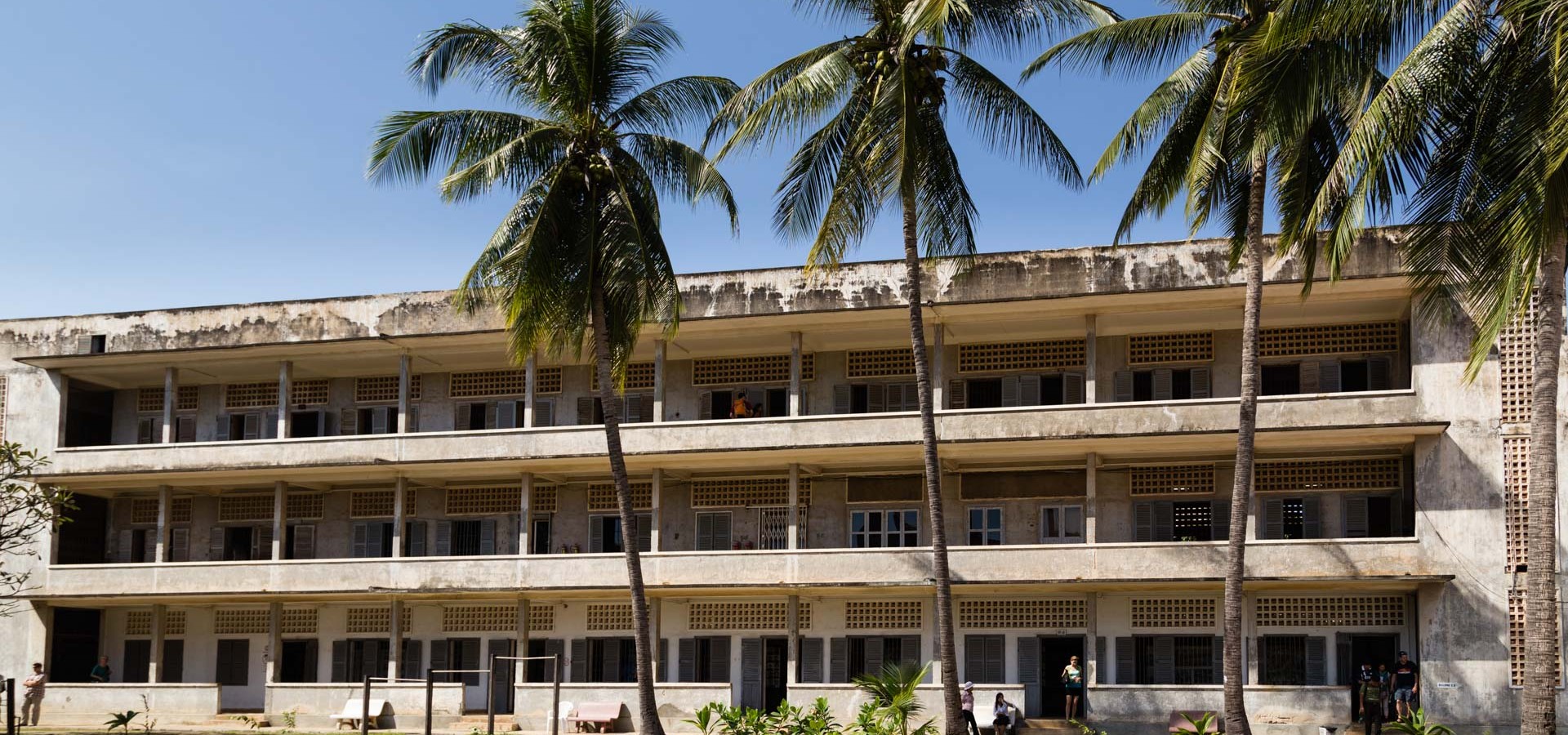Most visitors to Cambodia come to discover the stunning temples of Angkor near Siem Reap. Nevertheless, no travel to this country would be complete without visiting both the “Security Office 21” or S21 (Torture Prison) of Tuol Sleng and the Killing Fields in Choeung Ek, each extremely depressing and haunting experiences. These two places display without filter one of the darkest and most gruesome pages of recent history, the Killing Machine of the Khmer Rouge.
The Killing Machine
The Khmer Rouges took over Phnom Penh on April 17, 1975 and that very same day, they started to make 2 million people leave the city under the pretense of possible Vietnamese and American air raids. This evacuation didn’t take more than a few days. The “New People”, as the urban population was now referred to, were taken into the countryside, where they were forced to work in the rice fields or build irrigation canals.
Intellectuals, teachers, politicians and soldiers of the old regime were the first ones to be arrested and taken to prison centers to be tortured and then exterminated. There were 167 “Security Offices” and 343 “Killings Fields” in the country.
Very soon, it showed that Pol Pot’s vision of a perfect society, based on collective farming, would fail. Although almost the entire population was working in the fields, there was famine. This nightmare did not go unnoticed and some Khmer Rouge cadres tried to defect to Vietnam, others uttered mild criticism, a death sentence if caught. This is when the 4 “Brothers” became even more paranoid, filling the prisons with more and more of their own people. The term Angkar (meaning “Organization” in Khmer) became a synonym for an omnipresent and mysterious power, a coining for the Communist Party (Khmer Rouges / Pol Pot), which acted in complete secrecy.
S21 – Security Office 21: the Torture Prison of Tuol Sleng
This school – turned – into – prison was Cambodia’s largest “Security Office”, especially designed for the interrogation, torture and extermination of anti “Angkar”, or what a paranoid clique of Khmer Rouge leaders thought was such.
Building A is probably the most horrifying section, where the political prisoners, often Khmer Rouge cadres, were kept in single cells, shackled, and tortured. In each cell the gruesome image of a person tortured to death brings the suffering to a new dimension. These pictures were taken by the Vietnamese army, when they liberated Cambodia of the Khmer Rouges in 1979.
Other buildings contain equally horrifying evidence. There, “normal people” were imprisoned. Either they were kept in miniature cells with chains shackled to the floor or held in large mass cells where their legs were shackled to a piece of iron bar. They were regularly tortured. The rules were rigid and inhuman. Anyone breaking them was tortured. The guards were teenagers taken from remote villages, uneducated and eventually trained to kill.
The hundreds of photos of prisoners on display are haunting. Prisoners were photographed when they arrived at the prison, before and after torture. The fear in their eyes makes you cringe. One of the photos nobody ever forgets is that of the wife of a top official of the Khmer Rouge holding her baby. Her eyes and resigned facial expression tell that she knew exactly what was going to happen to her and her family.
People would confess to most imaginary crimes under torture. Then, those who did not die under torture were sent to the Killing Fields and exterminated. Everything was held for the record, filling thousands of pages. Approximately 17.000 people were killed in S21. There were only seven (!!!) survivors amongst the inmates.
The leaders of the Khmer Rouges denied any knowledge of the existence of these death camps. Since it was impossible to determine who was supporting simply the Khmer Rouges and who was pressured to commit these atrocious crimes, a general amnesty was granted in 1991. The fatal part of this decision was that the top command of the Khmer Rouge was let off the hook. Pol Pot or Brother Number 1, as he was called, died of Malaria in 1998. Other top Khmer Rouges leaders and criminals lived in Cambodia unharmed until 2007.
Then finally Brother Number 2 and Brother Number 9 were arrested and brought to justice by an International Court under the supervision of the United Nations. Their trial is still ongoing, and the Cambodian Government does all it can to avoid sentencing these mass murderers. So far, only the head of S21, Kaing Kek Lev, also called “Duch”, has been sentenced to life in prison and is indeed serving this sentence.
On the day of our visit, we had the unexpected privilege of meeting Chum Mey and Bou Meng, the last 2 of only 7 survivors of S21 who are still alive today. Despite the indescribable suffering they endured there, both men have the unbelievable strength to come back to the place of their torment to sign their book and talk to visitors. What drives them is to inform what happened and why, hoping to prevent such madness from happening again. Unfortunately similar atrocities took place again in Rwanda, in Darfur, in Easter Congo (DRC) and might be happening at the moment of writing without us knowing…
Of course we appreciated being able to buy the books of Mr. Chum Mey & Bou Meng!
The Killing Fields of Choeung Ek
During the Cambodian Genocide, at this site the unspeakable horror of the Pol Pot Regime reached its climax. Just 15 kilometers outside of Phnom Penh, this is the place where between 1975 and 1979, an estimated 20,000 prisoners were executed. Here, the Khmer Rouge brought those prisoners who had survived the interrogation and torture at S21.
The vision of Pol Pot’s ideal society required to erase all traces of civilization, money, markets, books, spectacles, property, anything linked to culture and education. The goal was to create a rural egalitarian society based on collective farming.
Anybody could end up in the Killing Fields: former politicians, intellectuals, teachers, farmers, workers, women, children, monks, foreigners … It was completely random and soon the Khmer Rouge cadres were targeted, even at the last Pol Pot’s best friend, especially when it became obvious that the “project” was failing. Although most Cambodians were forced to work in the fields, a famine of unknown dimension hit the country. Scapegoats had to be found: “spies” working for the hated Vietnamese and Americans. Prisoners were tortured until they would confess to crimes they never committed and were then executed.
The centerpiece of this memorial is a high tower divided into layers, filled with the 8,950 skulls removed from the 86 excavated mass graves (out of 129) there. It is a ghostly, horrid sight that becomes even more alive when the guide reveals some of the torment and cruelty these prisoners were subjected to.
The Khmer Rouge recruited very young, uneducated men from rural areas, not older than 15 and systematically prepared them for their “task”. Once prisoners arrived at Choeung Ek, they had to line up, kneeling or squatting in front of a very deep ditch, hands tied behind their back and blindfolded. They were hit over the head with a bamboo stick or an ax, often their throats were cut with banana tree leaves and they were then pushed into the ditch. The Khmer Rouge never used guns to kill their victims, because bullets were too expensive. It can be assumed that many victims were still alive when they were buried. Then DDT, a strong poison, was spread over the pile of bodies, to avoid the smell of the decaying bodies being detected by prisoners and farmers in the surrounds.
The number of people found in each of those mass graves differs greatly, from a few to over 400. Often a grave contained a whole family, because the Khmer Rouge believed that “the evil” could only be extinguished by killing all the family members of the accused. The skulls and graves are the only evidence left. All buildings and torture instruments have disappeared or were destroyed.
The code 3 – 8 – 20 stands for three years, eight months and twenty days: the period the Cambodian population was literally enslaved. When the Khmer Rouge terror regime was finally ended by the Vietnamese invasion, an estimated two to three million people were dead, murdered, starved to death, or killed by illness and exhaustion.
Practicalities:
We strongly recommend taking a guide at S21, who can provide more intimate details. The lady who took us around in 2008 was 14 years old when she was made to leave Phnom Penh and labor in the rice fields. Only one cousin of her extended family survived. Our guide in 2014 was much younger but had a wealth of knowledge about this period.
The audio system at the Killing Fields is excellent – if disheartening. The interviews of survivors are difficult to stomach, but extremely moving – they show the dimension of the horror and of the madness of the Khmer Rouges.
Learn more about the stunning Temples of Angkor near Siem Reap.




